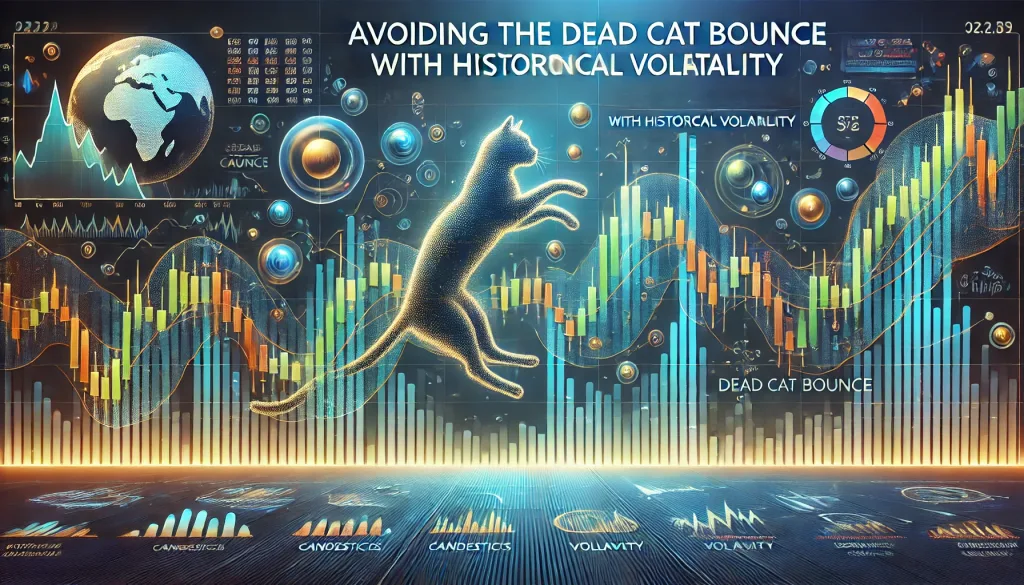Why Historical Volatility is a Trader’s Secret Weapon (And How to Avoid the “Dead Cat Bounce”)

Unpacking Historical Volatility: The Silent Market Whisperer
Imagine walking into a library where every book tells you how often the market freaks out. That’s historical volatility—a measure of how much the price of an asset swings over a specific period. Think of it as the market’s emotional diary, revealing past mood swings to help predict future drama. By understanding historical volatility, traders can navigate wild price movements and steer clear of impulsive decisions.
But here’s the kicker: volatility isn’t always bad. It’s like spice in cooking—a little can elevate the dish, but too much can ruin it. And if you misjudge it? Well, your portfolio might end up as empty as the calorie count on a cheat day.
What’s a “Dead Cat Bounce” (And Why Traders Keep Falling For It)
Before you grab the tissues, let’s clear this up: no actual cats were harmed in the making of this trading term. A “dead cat bounce” refers to a temporary recovery in the price of a declining asset, often luring unsuspecting traders into thinking the worst is over—only for the price to tumble again. Think of it like a “just kidding” from the market.
Here’s the funny part: even seasoned traders occasionally fall for this trap. Why? Because hope is a powerful thing. It’s like thinking your favorite canceled TV show will come back—a nice thought, but unlikely.
How Historical Volatility Helps Avoid the “Dead Cat Trap”
- Spotting the Fake Bounce: Historical volatility provides the context you need to spot fakeouts. If a stock’s bounce falls within its typical volatility range, it’s probably just noise.
- Setting Realistic Expectations: By analyzing historical data, you’ll know whether the price movement is a genuine reversal or a short-lived uptick.
- Timing Entry Points: Use volatility to identify safer entry points. For instance, wait for price movements to stabilize before committing.
Advanced Techniques: Mastering Historical Volatility
The Hidden Patterns You Need to Know
- Volatility Clustering: Markets tend to move from periods of high volatility to low volatility and vice versa. This pattern helps traders anticipate shifts.
- The Volatility Smile: In options trading, implied volatility often forms a smile-shaped curve—a clue to potential price extremes.
The Forgotten Strategy That Outsmarted the Pros
Savvy traders use historical volatility to refine risk management. For example:
- Calculate the average true range (ATR) to set dynamic stop-loss levels.
- Use Bollinger Bands to identify overbought or oversold conditions based on historical price data.
Case Study: How One Trader Turned Volatility Into Victory
Meet Sarah, a Forex trader who spotted a “dead cat bounce” in EUR/USD. Instead of jumping in, she analyzed historical volatility. Noticing the bounce was within typical fluctuations, she waited. A week later, the pair plummeted—and she avoided a costly mistake. By focusing on volatility metrics, Sarah turned what could have been a disaster into a masterclass in patience.
Ninja Tactics for Spotting and Profiting From Volatility
- Follow the Economic Calendar: Major events (like interest rate decisions) often cause volatility spikes. Use tools like StarseedFX’s Forex News Today for real-time updates.
- Join a Community: Surround yourself with experienced traders. The StarseedFX Community offers insider tips and live analysis.
- Keep a Trading Journal: Record your trades to track how you’ve handled past volatility. Use StarseedFX’s Free Trading Journal for advanced tracking.
Conclusion: Don’t Be the Trader Who Bought the Cat
Historical volatility isn’t just a metric—it’s a roadmap. By understanding it, you can avoid the pitfalls of “dead cat bounces” and seize opportunities that others miss. Remember, trading is like a marathon, not a sprint. Equip yourself with the right tools, stay informed, and laugh off your mistakes (because there will be plenty).
And if you ever feel lost? Well, there’s always room in the StarseedFX community for one more savvy trader.
—————–
Image Credits: Cover image at the top is AI-generated
PLEASE NOTE: This is not trading advice. It is educational content. Markets are influenced by numerous factors, and their reactions can vary each time.

Anne Durrell & Mo
About the Author
Anne Durrell (aka Anne Abouzeid), a former teacher, has a unique talent for transforming complex Forex concepts into something easy, accessible, and even fun. With a blend of humor and in-depth market insight, Anne makes learning about Forex both enlightening and entertaining. She began her trading journey alongside her husband, Mohamed Abouzeid, and they have now been trading full-time for over 12 years.
Anne loves writing and sharing her expertise. For those new to trading, she provides a variety of free forex courses on StarseedFX. If you enjoy the content and want to support her work, consider joining The StarseedFX Community, where you will get daily market insights and trading alerts.
Share This Articles
Recent Articles
The GBP/NZD Magic Trick: How Genetic Algorithms Can Transform Your Forex Strategy
The British Pound-New Zealand Dollar: Genetic Algorithms and the Hidden Forces Shaping Currency Pairs
Chande Momentum Oscillator Hack for AUD/JPY
The Forgotten Momentum Trick That’s Quietly Dominating AUD/JPY Why Most Traders Miss the Signal
Bearish Market Hack HFT Firms Hope You’ll Never Learn
The One Bearish Market Hack High Frequency Traders Don't Want You to Know The

